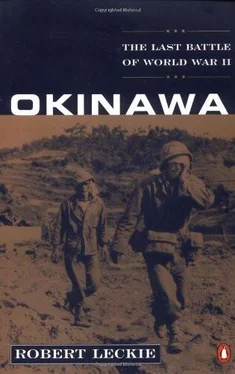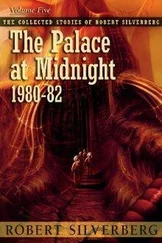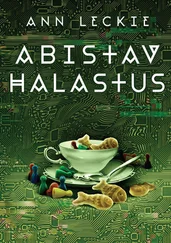In their headquarters below Shuri Castle a sorrowing General Ushijima and a despairing General Cho heard nothing but depressing reports from the front. Nevertheless, it was still hoped that a battalion of the Twenty-second Regiment that had slipped through American lines undetected to enter the Ginowan area might hide out in caves until daybreak, when they could emerge to shoot up the American rear echelons—and even perhaps reach Yontan and Kadena to destroy enemy aircraft. But in scattering for sanctuary during the night, they had become so fragmented that daybreak showed them incapable of concerted action. So they remained hidden until nightfall of the thirteenth, when half of them successfully slipped back into their own lines. Two final Japanese counter-attacks were repulsed during the early-morning darkness of the fourteenth, one of them with losses of 116 men, closing out Isamu Cho’s abortive counter-offensive.
It had not, of course, been a proper Banzai!: howling, sake- crazed troops, screaming and screeching as they ran through the darkness banging canteens on bayonets and yelling in singsong English what they presumed to be blood-curdling oaths—“Japanese boy drink American boy’s blood!”—only to be herded into enemy barbed wire by American mortars falling behind them, there to be riddled or sometimes even exterminated by accurate machine-gun and rifle fire. But it was still a reversion to bamboo-spear tactics, and worse, a decision to come outside of the caves and tombs and pillboxes from which they had successfully halted the two-division advance of General Hodge’s Twenty-fourth Corps, and expose themselves to the devastation of overwhelmingly superior American artillery, mortar, and naval gunfire, as well as accurate small arms. Ushijima, in authorizing this romantic regression into the failed tactics of the past, had blessed an operation ill conceived, understrength, misdirected, haphazard, and uncoordinated. As a result, more than half the force involved—1,594 men—were killed. To approve a plan calling for splendid defensive fighters to take the offensive at night while moving over unfamiliar terrain and woefully inferior in numbers and firepower was simply to grasp the muzzle of military success rather than the pistol grip; and also to surrender his own enormous advantage in terrain and tenacious troops: natural obstacles made unassailable by improved fortifications, thus canceling out his enemy’s superior firepower, and manned by invisible troops movable only in death.
He did this because, like Isamu Cho, his heart had conquered his head; and because most Japanese commanders from Midway-Guadalcanal to Okinawa itself could never shed that Bushido- born, carefully cultivated conviction that the soft, spoiled, luxury-loving Americans would quail at the first flash of a Samurai saber.
Kikusui 2 : Kamikaze Crucible
CHAPTER THIRTEEN
Admiral Matome Ugaki was still convinced that his April 6-7 strikes at the Americans had seriously damaged TF 58, an estimate not shared by his colleague, Lieutenant General Michio Sugahara of the Sixth Air Army. A report made by Sugahara’s staff somewhat sourly concluded: “Despite many attacks, the Navy cannot block the enemy’s carrier force, which still is operating east of Okinawa.”
Nevertheless Sugahara was eminently cooperative in preparing for Kikusui 2, which Ugaki hoped would so shatter Spruance’s fleet that it might seek sanctuary in the open sea. But both he and the army general realized that the second Floating Chrysanthemum would never equal the strength of the first, if only because of the serious losses it had suffered. They were also concerned to learn that Marine Corsairs had indeed arrived at Yontan and Kadena, thus menacing their own aircraft with ground-based fighters that, because of their proximity to their base, were more to be feared than carrier-based interceptors.
Their apprehension was somewhat eased, however, with the arrival on Kyushu of a new weapon: the Oka, or “Cherry Blossom” glide bomb, a rocket-boosted, piloted suicider capable of speeds of 500 knots and carrying a huge wallop of 2,645 pounds of trinitroanisol. The Oka was slung beneath a mother plane, usually a heavy Betty or Peggy bomber, and flown to within about a dozen miles of its target, when it was released with the pilot firing its rockets and directing it toward its target. Moving at pistol-bullet speed, the Oka was believed to be almost immune to enemy gunfire, but its very velocity made it extremely difficult for its pilot to keep his 16½-foot missile on target. American intelligence was aware of the appearance of this new weapon, but considered it so ineffective that it was christened baka, or “foolish.”
Although Kikusui 2 was scheduled for April 12, Admiral Ugaki tried to destroy “the remnant” of TF 58 on the day before, hurling a daylight suicide attack of about fifty-two planes against Admiral Mitscher’s carrier force. Typically glowing reports claimed three carriers sunk, a cruiser set ablaze, another cruiser holed, and two destroyers hit with torpedoes. The next day Ugaki’s pilots, still mightier with pen than bomb, reported sinking two battleships and a light cruiser. Actually very little damage was done to Mitscher’s ships on either day. Some damage was inflicted on the veteran flattop Enterprise, and a kamikaze crashed the majestic new battleship Missouri, but succeeded only in scratching her deck and blistering some paint. Destroyer Kidd was hit on picket duty and badly hurt, with thirty-eight sailors killed and fifty-five wounded, the worst casualty of the day. Waggish bluejackets aboard another picket destroyer, exasperated by repeated strikes at their station, erected a huge sign on deck with an arrow pointing aft and reading: CARRIERS THIS WAY.
Both Ugaki and Sugahara hoped to neutralize the enemy Corsairs by planning a series of bombing raids on their airfields the night before the scheduled attacks of April 12, while Sugahara also organized a decoy flight of fighters to lure TF 58’s Hellcats and Corsairs away from the impact area. In the bombing operation, 22 Japanese aircraft struck Yontan and Kadena shortly before dawn of the twelfth, damaging 5 enemy planes but losing 5 of their own to American gunners of all services. Next, Sugahara’s decoys attracted nothing but birds rising for dawn breakfasts, so that it was not until eleven o’clock in the morning that the Kyushu main body of about 120 late-model fighters arrived over both Kikai Jima and the Hagushi Anchorage to try to clear the strike area for following flights of 76 kamikaze, plus 20 suiciders roaring up from Formosa.
Although the Nipponese fighters were more successful than usual against the more skillful Americans flying better planes—claiming a probably exaggerated 20 kills—the Navy and Marine pilots from the carriers of TF 58 reported a much higher 126 enemy planes downed during fighter sweeps. This also was probably exaggerated—not by intent like the starry-eyed enemy—but from the inevitable duplication occurring when more than one fighter was firing on the same enemy, or even when a “flamer” plunging toward a watery grave might have the winds caused by his velocity blow the fires out, enabling him to return successfully to base. “Kill” estimates like body counts were much like American taxpayers’ income-tax returns: so full of deductions for charity that the churches of America would all be rich “beyond the dreams of avarice.”
But the American interceptors did effectively prevent the enemy fighters from protecting the kamikaze. Although the suiciders succeeded in damaging eight American ships—mostly destroyers and destroyer-escorts of the radar picket line, as well as some smaller craft—and causing high casualities, only one warship was sunk: the new picket destroyer Manert L. Abele, the first kill on record by a baka bomb.
Читать дальше










